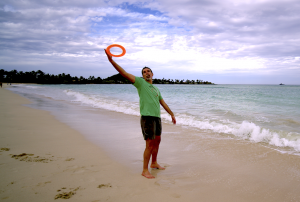 I was practicing my counter airbrushing in high wind the other day and I had an “ah ha!” moment. You see, I have been great at brushing clock in high wind for a while, but only recently have I decided to seriously practice counter in high wind. In the past I was happy to have just enough counter skill so I could control the disc to pass or immediately catch it. More recently, I’ve decided it’s time to master counter. It’s actually quite challenging, but in a different way then when I learned clock. Now when the wind is high – I know I can brush clock all day long and have a blast. But, if I start brushing the disc counter, after two or three brushes, it soon drops or blows away. Maximum frustration.
I was practicing my counter airbrushing in high wind the other day and I had an “ah ha!” moment. You see, I have been great at brushing clock in high wind for a while, but only recently have I decided to seriously practice counter in high wind. In the past I was happy to have just enough counter skill so I could control the disc to pass or immediately catch it. More recently, I’ve decided it’s time to master counter. It’s actually quite challenging, but in a different way then when I learned clock. Now when the wind is high – I know I can brush clock all day long and have a blast. But, if I start brushing the disc counter, after two or three brushes, it soon drops or blows away. Maximum frustration.
So, the other day the wind was up past my comfort zone with counter. I decided to “pay my dues” and just keep at it, no matter how frustrating it got. This is what lead me to my “aha!” moment. I found that when the disc was getting away from me, when I had to make my maximum effort to get to it, I’d arrive to a place where I could reach it, but not at a place where I had options to make a save. I was literally putting myself out of position to make the play.
“Why is this, what am I doing wrong?” I asked myself. One of the most important skills I had learned early on was to judge where the disc was going to land, then calculate where I could meet it before it hit the ground, and then run straight to that point. This was the skill I was applying, but it was letting me down.
I had apparently learned a more nuanced skill with clock spin, but not realized it. The spin of the disc changes how the disc flies through the air. More wind makes this even more pronounced. A clock disc will tilt to the left (forcing my body to twist toward the right) and a counter disc will tilt to the right (forcing my body to twist to the left). The tilting of the disc, of course, changes the flight path, but it changes another thing as well: the it’s direction relative to the wind, i.e. where the nose is pointing.
As I pursued the counter spinning disc, I was considering the flight path, but not the disc’s direction to the wind. My muscle memory for clock spin was causing me to arrive at the counter spinning disc with the nose pointing off to my left, leaving me with limited options. I needed to not only meet the disc, but meet it at a place where I had the maximum options for addressing it. In other words, I had to get “behind it”, which is a different place for counter than it is for clock.
Making this adjustment was quite challenging. It was a little like fighting against an instinct. The more I forced it, the easier it got and soon I found options for saving the disc that were not there before. As this adjustment became more natural, I started to see the counter spinning disc falling into the pocket for more catches! This shift in thinking opened up my counter brushing game and gave me a deeper level of insight into freestyle skills.
If you are working on your brushing game, here’s a tip: as you pursue the disc, consider it’s flight path and it’s tilt relative to the wind and run straight to the place that gives you the most options. I call this place “behind the disc.” This way, as you brush it back up into the wind, the nose will be pointing away from you, causing the disc to float out, and then right back to you.
Need some more airbrushing advice? Here are some great videos and another informative article.




